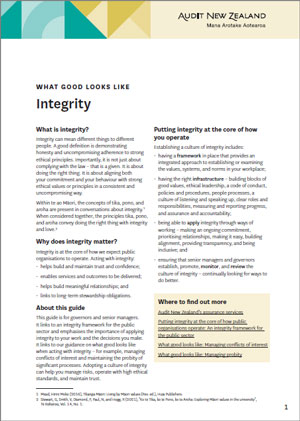What good looks like: Integrity
This is part of our series on What good looks like, produced by our Specialist Audit and Assurance Services team.
 What is integrity?
What is integrity?
Integrity can mean different things to different people. A good definition is demonstrating honesty and uncompromising adherence to strong ethical principles. Importantly, it is not just about complying with the law – that is a given. It is about doing the right thing. It is about aligning both your commitment and your behaviour with strong ethical values or principles in a consistent and uncompromising way.
Within te ao Māori, the concepts of tika, pono, and aroha are present in conversations about integrity.1 When considered together, the principles tika, pono, and aroha convey doing the right thing with integrity and love.2
Why does integrity matter?
Integrity is at the core of how we expect public organisations to operate. Acting with integrity:
- helps build and maintain trust and confidence;
- enables services and outcomes to be delivered;
- helps build meaningful relationships; and
- links to long-term stewardship obligations.
About this guide
This guide is for governors and senior managers. It links to an integrity framework for the public sector and emphasises the importance of applying integrity to your work and the decisions you make. It links to our guidance on what good looks like when acting with integrity – for example, managing conflicts of interest and maintaining the probity of significant processes. Adopting a culture of integrity can help you manage risks, operate with high ethical standards, and maintain trust.
Putting integrity at the core of how you operate
Establishing a culture of integrity includes:
- having a framework in place that provides an integrated approach to establishing or examining the values, systems, and norms in your workplace;
- having the right infrastructure – building blocks of good values, ethical leadership, a code of conduct, policies and procedures, people processes, a culture of listening and speaking up, clear roles and responsibilities, measuring and reporting progress, and assurance and accountability;
- being able to apply integrity through ways of working – making an ongoing commitment, prioritising relationships, making it easy, building alignment, providing transparency, and being inclusive; and
- ensuring senior managers and governors establish, promote, monitor, and review the culture of integrity – continually looking for ways to do better.
Where to find out more
Audit New Zealand’s assurance services
What good looks like: Managing conflicts of interest
What good looks like: Managing probity
Page created: 8 November 2022
